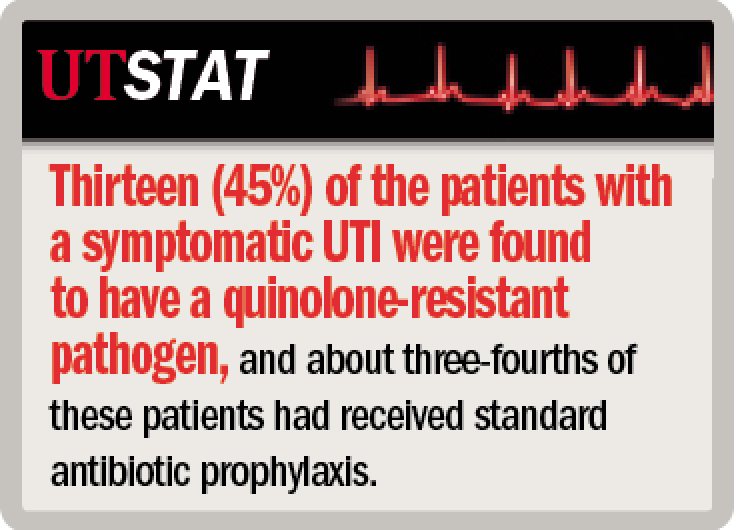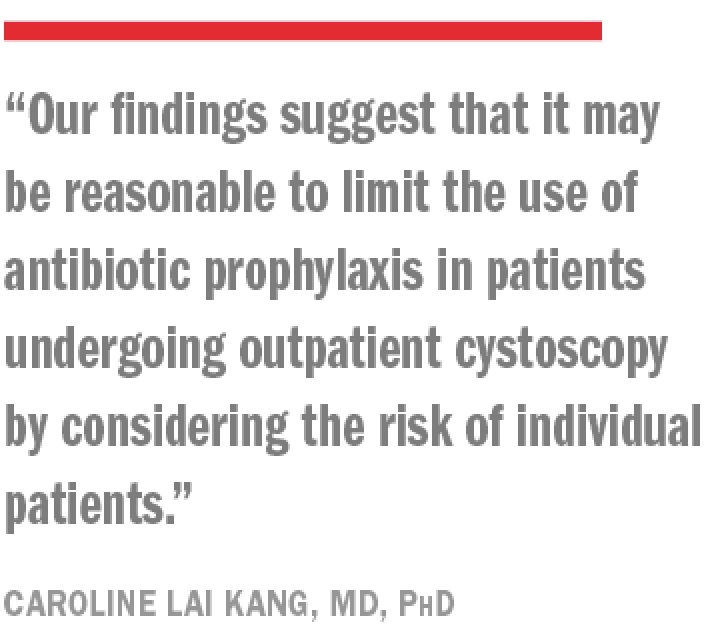Article
Post-cystoscopy urinary tract infection uncommon
Symptomatic urinary tract infection is unlikely after office-based cystoscopy, although recent antibiotic exposure or hospitalization raise infection risk, according to a recent study.
Nashville, TN-Symptomatic urinary tract infection (UTI) is unlikely after office-based cystoscopy, although recent antibiotic exposure or hospitalization raise infection risk, according to a recent study.
Have you read: Pre-op antibiotics sufficient to prevent UTI during stone Tx
Understanding the risk factors for UTI after office-based cystoscopy and the causative pathogens should enable the development of optimal approaches to prophylaxis. With that goal in mind, researchers at Vanderbilt University Medical Center, Nashville, TN, undertook analyses to investigate the causes of and associated risks for UTI.

The results, which were presented at the AUA annual meeting in New Orleans, showed that the occurrence of symptomatic UTI is likely uncommon. However, recent antibiotic exposure, hospitalization, or recent non-genitourinary (GU) infection were risk factors for the event, and the infections were often due to fluoroquinolone-resistant organisms in patients who received prophylaxis with a fluoroquinolone.
“Studies investigating the efficacy of prophylaxis for UTI after office-based cystoscopy have produced mixed results. Our findings suggest that it may be reasonable to limit the use of antibiotic prophylaxis in patients undergoing outpatient cystoscopy by considering the risk of individual patients,” said co-author Caroline Lai Kang, MD, PhD, a urology resident at Vanderbilt who worked on the study with Daniel Barocas, MD, MPH, and colleagues.
“Then, when choosing a prophylactic antibiotic regimen for cases where prophylaxis is deemed appropriate, one should evaluate resistance and susceptibility patterns on the local antibiogram to determine the most appropriate agent.”
Also see: Risk calculator predicts breakthrough UTIs in reflux patients
The study was performed by reviewing the charts of patients who underwent outpatient cystoscopy between April 2012 and May 2014. Patients with positive urine cultures within 30 days of cystoscopy were reviewed for the presence of symptomatic UTI, which was defined as having a single symptom (fever, urgency, frequency, dysuria, prostate tenderness, or suprapubic tenderness) with a culture of >105 colony-forming units per high-power field or two symptoms along with a positive urinalysis or physician-diagnosed UTI.
Of the 5,488 patients who were identified, 29 (0.53%) developed a symptomatic UTI within 30 days after the procedure. The authors cautioned, however, that this is not a true rate of infection as not all charts were reviewed and data did not include patients who may have presented at outside facilities.
NEXT: High rate of quinolone-resistant pathogens
High rate of quinolone-resistant pathogens

The most commonly isolated uropathogens were Escherichia coli (29%), Klebsiella spp. (21%), and Pseudomonas spp. (17%). Thirteen (45%) of the patients with a symptomatic UTI were found to have a quinolone-resistant pathogen, and about three-fourths of the 13 patients had received standard antibiotic prophylaxis, which consisted of a single perioperative oral dose of a fluoroquinolone antibiotic.
Have you read: Diet, urine pH may affect urinary tract bacterial growth
“These findings suggest patients had a breakthrough UTI and point to the importance of considering local antibiotic resistance patterns when choosing an antimicrobial agent for UTI prophylaxis,” Dr. Kang said.
Clinical characteristics associated with UTI were examined by performing a nested case control analysis that matched each of the UTI cases with four controls based on provider, office, diagnosis code, and procedure code. The variables analyzed included demographic characteristics, history of diabetes, current smoking status, immune suppression, external catheter/intermittent catheterization, non-GU tract instrumentation within 1 month, non-GU infection within 1 month, hospitalization within 1 month, receipt of antibiotics within 6 months, and receipt of a standard pre-cystoscopy antibiotic dose.
In addition, several of the variables were combined into composite variables to maximize statistical efficiency and power. The composite variables were host factors (immunosuppression, diabetes, current smoker), recent health care or antibiotic exposure (hospitalization within 1 month, non-GU infection within 1 month, antibiotic use within 6 months), and urinary colonization (catheter or intermittent catheterization or instrumentation of the GU tract within 1 month).
Also read: Novel agent may protect against major UTI pathogen
In univariate analysis, the only variables that were significantly associated with UTI were having an external catheter/intermittent catheterization, being hospitalized within the previous month, having received an antibiotic within the past 6 months, and the composite variable of recent health care or antibiotic exposure.
In multivariable logistic regression analysis, the composite variable of recent health care or antibiotic exposure was the only independent predictor. Patients with any of the characteristics encompassed within that composite variable had a 5.26-fold greater risk for having a symptomatic UTI compared with their counterparts without any recent health care or antibiotic exposure.
The findings will be published in an upcoming issue of Urology Practice.
Subscribe to Urology Times to get monthly news from the leading news source for urologists.
















